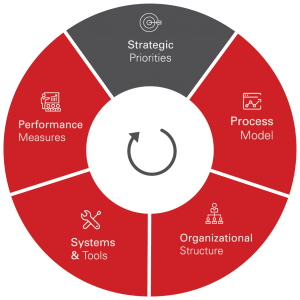This is part 1 of a 5 part blog series on effectively defining an operating model for your organization.
In this post, we will explore Step 1: Defining the Strategic Priorities
Strategic planning is often done in the C-Suite. However, it is important for functional leaders to develop a strategic plan and an operating model that aligns their team to the corporate strategy. 
I’m not going to dive too deep into the approach for defining a strategy in this post. Rather, I do want to focus on the need to define the top 3-5 strategic priorities that will move the needle for the organization.
Sounds fairly simple right? There is definitely an art to identifying and landing on the right list of strategic priorities that are going to make a significant impact on the organization. So whether you lead the entire company or a large functional team, you can use strategic priorities as the foundation to build your operating model and rally your team around.
Below are a few key considerations when establishing the right strategic priorities for your organization.
Be Open to Learning
Start by performing a comprehensive environmental scan, (Customers, Industry, Competitors, Environment, Internal Assessment) to truly uncover key insights. My favorite description of key insights comes from Willie Pietersen, in his book Strategic Learning. He defines key insights as the “The brutal truths” about the external environment and internal realities which will enable us to make the most intelligent choices. He also outlines the importance of framing the “do or die” issue or issues that must be dealt with.
Too often, information is filtered as it works it’s ways through the organization into the executive ranks. It can get so watered down that it is no longer addressing the “brutal truths”. By fostering a culture and commitment to learning, leaders will have a higher likelihood of seeing the information through an objective lens. It’s so important that the team members accountable for delivering the insights are operating in a safe environment. That they can share information without risk.
Therefore, leaders also have to demonstrate an openness to receiving the insights. Brutal truths are not easy pills to swallow and the initial reaction may be to take a defensive posture. By establishing a learning mindset, leaders can protect themselves from rationalizing away the insights.
Foster Collaboration
Upon collecting the key insights from within and outside of the organization, leaders can get laser-focused on defining the strategic priorities.
So leaders have an opportunity to engage members of their teams that have a strong pulse of the organization and access to the insights. This doesn’t have to involve an executive retreat or being locked in a room with whiteboards of flip charts. It involves engaging the key folks that are interacting with your customers, suppliers, partners, and employees. The show Uncover Boss does an excellent job showing the impact on leaders when they are able to capture the insights directly by rolling up their sleeves.
Sometimes insights surface clear as day. But many times it takes a process of iteration and debate to find the right set of strategic priorities. So allow time for the insights to breathe and the opportunity to capture feedback from a variety of stakeholders to hone the priorities. Getting the right strategic priorities isn’t something that just happens in one night. (Unless you are Tom Cruise in the movie Jerry McGuire).
Put Energy Behind the Rollout
The strategic priorities will be the guideposts on which the operating model is built. In addition to shaping organizational decisions, they have a significant impact on initiative execution, employee behaviors, and shaping the overall culture.
Effective Strategic Priorities Are:
- Clear, concise, and easily understood by all stakeholder groups
- Critical inputs into the decision-making process (Value Proposition, Markets, Channels, Customers)
- Relevant to the day-to-day processes and desired outcomes
- Structured for organizational effectiveness
- Tied to measures and rewards
- Communicated through champions and leaders in the company to win over the employee base
The most significant takeaway from Willie Pietersen’s Strategic Learning process is that the strategic planning process is a cycle. So often, we think strategy and operational design as a linear process that has a finish line. Today’s economic forces are requiring the strategic assessment cycle to be more and more frequent and dynamic.
Building the Operating Model Around Strategic Priorities:
In the upcoming posts, I’ll focus on how an organization can put the operating model in place to achieve the strategic priorities in order to achieve the desired outcomes.
I’ll provide considerations and tips for implementing the components of the operating model, including:
- Taking a process model approach
- Structuring the organization
- Putting the right systems and tools in place
- Establishing the right performance measures
P.S. I learned the mission statement in Jerry McGuire was influenced by a memo sent by Jeffrey Katzenberg, in 1991 at Disney. It called for Disney to return to its roots and focus on storytelling.
P.S.S. You can read the whole 25 page Jerry Maguire memo here.
To learn more about effectively defining an operating model for your organization, you can download our guide below or you can find it on our website here.

